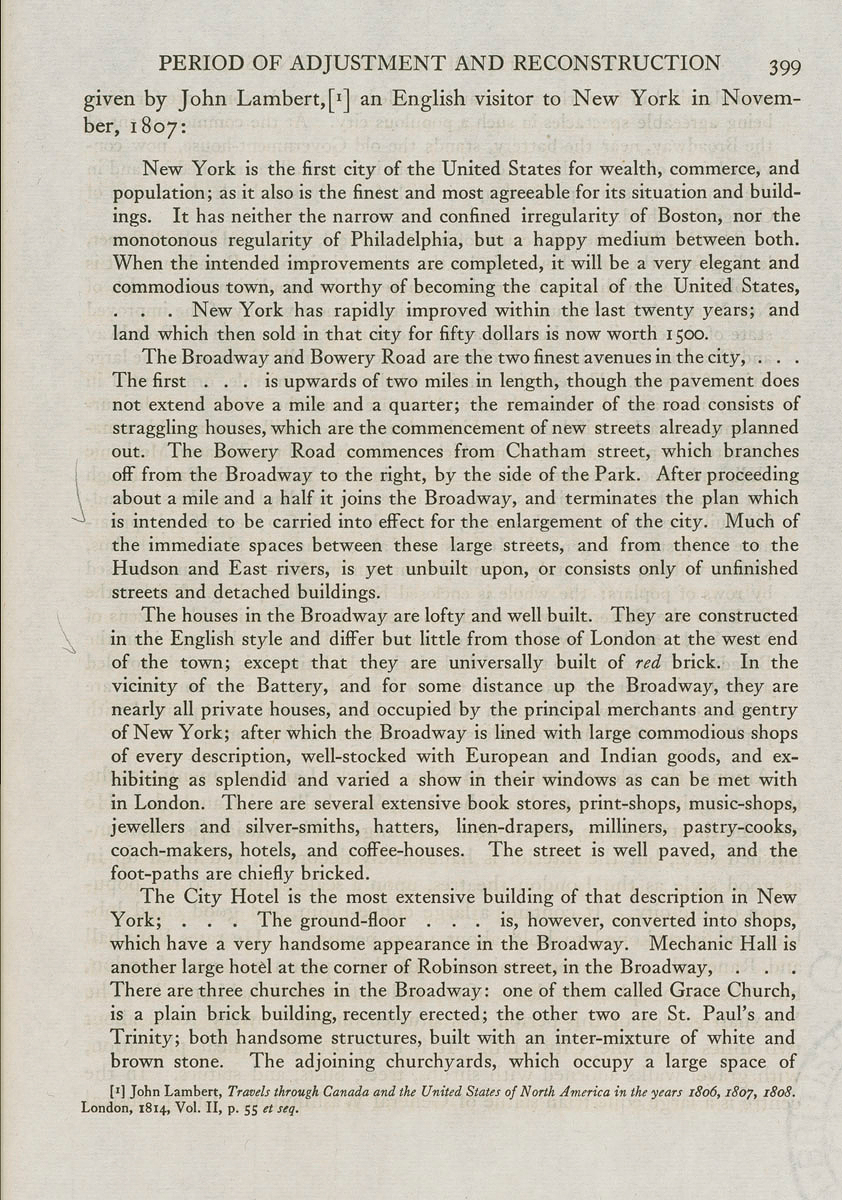1
-•ib
PERIOD OF ADJUSTMENT AND RECONSTRUCTION 399
given by John Lambert,[^J an English visitor to New York in Novem¬
ber, 1807:
New York is the first city of the United States for wealth, commerce, and
population; as it also is the finest and most agreeable for its situation and build¬
ings. It has neither the narrow and confined irregularity of Boston, nor the
monotonous regularity of Philadelphia, but a happy medium between both.
When the intended improvements are completed, it will be a very elegant and
commodious town, and worthy of becoming the capital of the United States,
. . . New York has rapidly improved within the last twenty years; and
land which then sold in that city for fifty dollars is now worth 1500.
The Broadway and Bowery Road are the two finest avenues in the city, . . .
The first ... is upwards of two miles in length, though the pavement does
not extend above a mile and a quarter; the remainder of the road consists of
straggling houses, which are the commencement of new streets already planned
out. The Bowery Road commences from Chatham street, which branches
off from the Broadway to the right, by the side of the Park. After proceeding
about a mile and a half it joins the Broadway, and terminates the plan which
is intended to be carried into effect for the enlargement of the city. Much of
the immediate spaces between these large streets, and from thence to the
Hudson and East rivers, is yet unbuilt upon, or consists only of unfinished
streets and detached buildings.
The houses in the Broadway are lofty and well built. They are constructed
in the English style and differ but little from those of London at the west end
of the town; except that they are universally built of red brick. In the
vicinity of the Battery, and for some distance up the Broadway, they are
nearly all private houses, and occupied by the principal merchants and gentry
of New York; after which the Broadway is lined with large commodious shops
of every description, well-stocked with European and Indian goods, and ex¬
hibiting as splendid and varied a show in their windows as can be met with
in London. There are several extensive book stores, print-shops, music-shops,
jewellers and silver-smiths, hatters, linen-drapers, milliners, pastry-cooks,
coach-makers, hotels, and coffee-houses. The street is well paved, and the
foot-paths are chiefly bricked.
The City Hotel is the most extensive building of that description in New
York; . . . The ground-floor ... is, however, converted into shops,
which have a very handsome appearance in the Broadway. Mechanic Hall is
another large hot^l at the corner of Robinson street, in the Broadway,
There are three churches in the Broadway: one of them called Grace Church,
is a plain brick building, recently erected; the other two are St. Paul's and
Trinity; both handsome structures, built with an inter-mixture of white and
brown stone. The adjoining churchyards, which occupy a large space of
[i] John Lambert, Travels through Canada and the United States of North America in the years 1806,1807, 1808.
London, 1814, Vol. II, p. 55 et seq.
|








